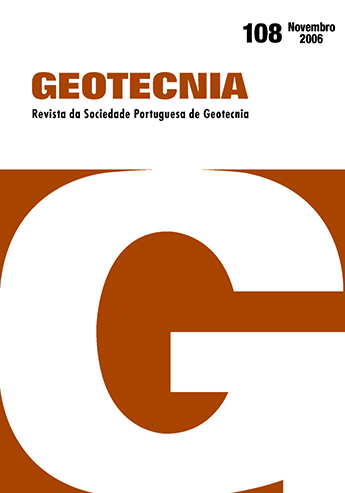Discrete element models applied to failure analysis of concrete dams’ foundations – a new discontinuity constitutive model
DOI:
https://doi.org/10.14195/2184-8394_108_1Abstract
A numerical model based on the discrete element method is presented, for the study of dam foundations in rock masses. A constitutive model for discontinuities was developed, which takes into account the softening of the cohesive component of shear strength and of the tensile strength. The field of application of the present model comprises studies of rock engineering structures that require a representation of the behavior of joints and interfaces, including deterioration and failure processes, namely concrete-rock interfaces, concrete lift joints in dams, and the propagation of non-persistent joints in rock masses. The constitutive model for joints was implemented in the discrete element programme 3DEC. A comparison with results of laboratory tests of fracture of a concrete beam showed a good agreement between numerical and experimental data. The model was also applied to the study of the safety of a concrete arch dam, for a failure scenario involving rising of the water level and sliding on a fault in the rock mass.
Downloads
References
Cundall, P., “A Computer Model for Simulating Progressive Large Scale Movements in Blocky Rocky Systems”. Proceedings of the Symposium of the International Society of Rock Mechanics, vol. 1, paper II-8, França, 1971.
Gomes, J., Lemos, J., e Pina, C., “Modelação Numérica e Experimental da Rotura pela Fundação da Barragem de Alqueva”. V. SEMNI – Métodos Numéricos en Ingeniería, Goicolea, J., Soares, C., Pastor, M., & Bugeda, G. (eds). Espanha, 2002.
Itasca, “3DEC: 3 Dimensional Distinct Element Code”. Version 2.0, User’s Manual Itasca Consulting Group, Mineapolis, EUA, 1999.
Kunieda, M., Kurihara, N., Uchida, Y., Rokugo, K., “Application of Tension Softening Diagrams to Evaluation of Bond Properties at Concrete Interfaces”, Engineering Fracture Mechanics, vol. 65, p. 299-315, 2000.
Lemos, J. V., “Development of an Arch Dam Analysis Module for the Program 3DEC”. Relatório LNEC, Portugal, 1998.
Lemos, J. V., “Modeling and Failure Analysis in Rock Engineering”. Programa de Investigação, LNEC. Portugal, 2001.
Liberal, O., Miranda, P., Monteiro, P., Paixão, J., Lima, C., & Moreira, A. “Tratamento de uma Zona de Falha de Grande Possança na Margem Esquerda da Barragem de Alqueva”. XII COBRAMSEG, Associação Brasileira de Mecânica de Solos e Engenharia Geotécnica (ed), p. 1135-1147, 2002.
Lourenço, P. e Rots, J., “Multisurface Interface Model for Analysis of Masonry Structures”, Journal of Engineering Mechanics, vol. 123, no 7, pp. 660-668, 1997.
Oliveira, S., “Modelos para a Análise do Comportamento de Barragens de Betão Considerando a Fissuração e os Efeitos do Tempo. Formulações de Dano”. Tese de Doutoramento, Faculdade de Engenharia da Universidade do Porto. Portugal, 2000.
Resende, R., “Um Modelo para o Estudo de Cenários de Rotura de Fundações Rochosas de Barragens”. Dissertação de Mestrado, Instituto Superior Técnico. Portugal, 2003.
Schclar, N. e Muralha, J., “Modelação Numérica dos Trabalhos de Tratamento da Falha 22 da Barragem de Alqueva”. 8º Congresso Nacional de Geotecnia, Sociedade Portuguesa de Geotecnia (ed), p. 2641-2652. Portugal, 2002.




